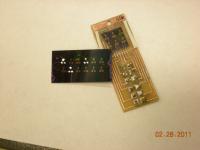Researchers at the University of Utah have developed spintronic transistors to align magnetic spins of electrons in silicon chips at room temperatures. The development is suitable for computers, phones and spintronic solutions.
Ashutosh Tiwari, an associate professor of materials science and engineering says the devices will utilize both the charge and the electrons spin. It will help develop faster and power efficient devices.
 UoU's Transistor on Silicon Chip
UoU's Transistor on Silicon Chip
The team has described its invention of room-temperature, spintronic transistors on a silicon semiconductor in the current issue of Applied Physics Letters. The electron spin aligned in a particular manner was injected into silicon chips and kept for a 276 trillionths of a second. The research received grants from the National Science Foundation.
The team utilized electricity and magnetic fields to inject spin polarized carriers with their spins arranged either all up or all down into silicon chips at room temperature. Magnesium oxide was used as a tunnel barrier to move the spins from one nickel-iron electrode to another through the silicon semiconductor. The absence of magnesium oxide made the spins randomize instantly, with half up and half down.
The team used a flat piece of silicon measuring 1x0.3inches and one-fiftieth of an inch thick. A thin sheet of magnesium oxide was applied to the silicon wafer. A dozen tiny transistors were placed on the silicon wafer to inject electrons into the silicon and track them. Each transistor had three contacts or electrodes, one through which electrons with aligned spins were injected and detected, a negative electrode and a positive electrode to measure voltage. Direct current was passed through the spin-injector electrode and negative electrode of each transistor. The current was stabilized and the variations in voltage were measured while depositing a magnetic field on the unit. This helped them determine the amount of spin injected and its lifespan. The electrons maintained their spins for 276 picoseconds.
Source: http://www.utah.edu/